
Supergiant Games is known for their hit titles such as Bastion and Transistor. They’ve once again come together to work on a new game, this time named Hades. The big question on everyone’s mind is whether it’ll maintain the quality they’re known for, or fall to the depths of hell as a failure of a game.
There isn’t much to the story other than the underworld’s prince seeking what lies beyond the hellish prison. Defying the god of the dead, you must climb higher and die trying. Pieces of the story will eventually come together with events you can trigger. Throughout the game, you’ll learn more about the inhabitants of your father’s domain and the deities beyond.
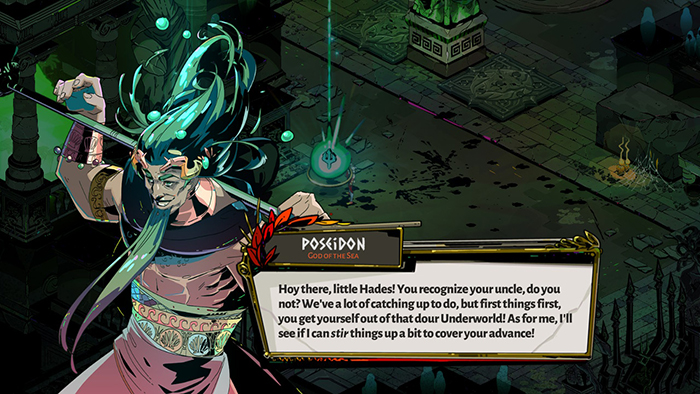
Hades is a fast-paced ARPG with roguelike dungeons that’ll have you hack and slashing your way through stages. It’s simple to pick up the basics and the controls work pretty well on the Switch. Your combat controls are all located in one convenient area, you move around with the left analog stick, and interact with the shoulder buttons (Summoning/Calling too). If you don’t like the default button configuration, you can set your own, which is amazing for a game where you’ll need to be responsive to enemy attacks.
To make it out of the underworld, you must ascend four biomes without dying in a single run. Death kicks you straight back to where you originally started. Any upgrades you’ve collected during the run will reset, staying true to its roguelike nature. Except for the coin, other forms of currency stay with you during your revival. Climbing will be no easy task, but there are multiple methods to make your ascent a comfier ride.
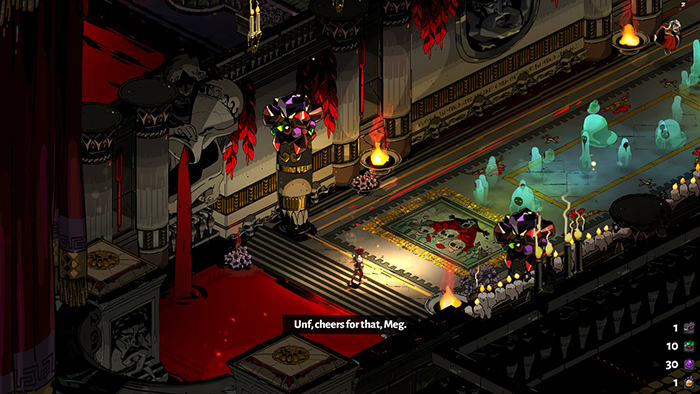
Although Hades is a brutal game, it has enough mercy upon the player to provide methods of healing during their climb. It does come with a price, but a sufficient price to pay for the benefit you’ll reap. Shops add to this, with the addition of purchasing one or two upgrades, provided you have the funds for them.
You’ll find yourself replaying Hades a lot. The game was built with replayability in mind until you’ve successfully climbed your way out of the depths of hell. Both enemies and layouts are random, so it’ll feel less of a burden clearing them repeatedly. What makes Hades so charming is how the protagonist and immortals keep you engaged with their voice acting. It always seems like the protagonist has something new to say. Most gods won’t abandon you during your climb, and it’s always nice to see what the house’s lot has to say after a failed escape attempt.
Each biome is divided into different areas that offer a reward upon completion. The layouts change with each visit and consist of different enemies a majority of the time. Unfortunately, you’ll see old, familiar faces with most visits, but from time to time you’ll encounter new ones. The game has its fair share of enemies, but most are unique inhabitants to their respective biomes.
Clearing a biome’s level sometimes prompts you with the choice of the next area. In these situations, you’ll have to choose between two or three rooms. A symbol will always be marked on the door, representing a vague reward from the aiding god. Deciding between rooms puts more power in your hands in deciding how you want to build up your character’s temporary strength during a run.

Occasionally, you’ll have the option of entering a room with two rewards. You’ll be forced to choose between the two gods for their reward and then face the consequences of the offended deity. The enemies you’ll face may be tougher than usual with some added obstacles to withstand. Overcoming the challenge rewards you with the god’s forgiveness and the unclaimed reward.
Sometimes you may even come across a suspicious portal during a run. You’ll have the choice of entering for a portion of your maximum HP. The primordial being within this area will offer temporary high risk, high reward upgrades. They’re strong, but will require a sacrifice before displaying their usefulness. It’s another optional method to achieve higher power.
As the prince of the Underworld, you use your choice of weapon capable of both a normal and special attack. You’re able to use a cast to damage enemies, charge up your attacks, and dash to dodge attacks or get around faster. It sounds simple, but the upgrades you acquire on your runs or from your mirror will enhance these skills. Auto-aim support makes connecting your attacks with enemies convenient. Swapping between weapons before a run changes your normal and special attack.
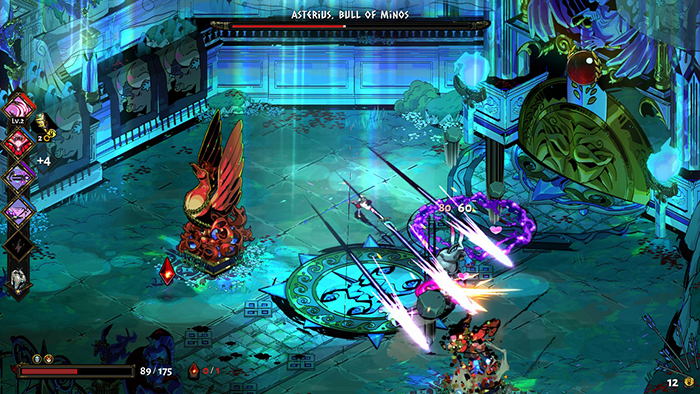
Each stage will have a number of enemies you’ll have to crush to advance further. They normally appear in hordes, but in manageable numbers. Although slaying them will summon more, it does not get overwhelming or time-consuming to clear. While fighting them, you must also try to avoid different types of triggerable traps. Some of these traps shoot arrows at you, drop a large axe from above, and stick you from below with spikes. They aren’t annoyingly difficult to avoid, but add a depth of difficulty to surmount.
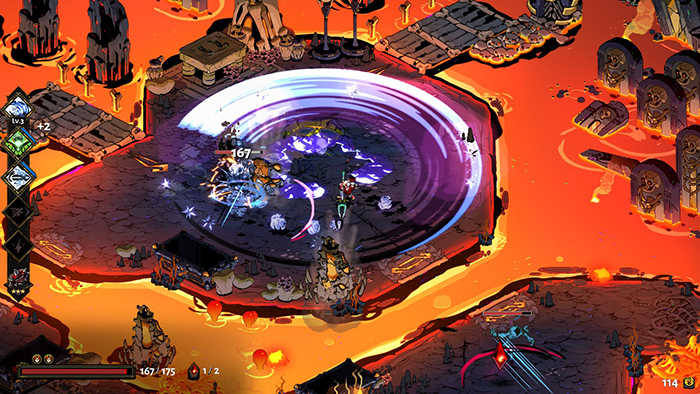
The variety of enemies in the game is sufficient to keep your satisfaction at bay, although more would have been most welcoming. Each monster type has a unique manner of attacking; two different types of enemies that rush at you can do it in different ways, for example. A Numbskull tackles you in one jump while the tougher Wretched Louts makes a clean dash. It goes without saying that the higher you climb, the tougher the enemies you’ll encounter. Some may often sport a yellow armor to boost their defensive capabilities (larger sum of HP and the protection from flinching). Regardless of that, it feels good to slay the challenging foes, but it’s frightening to look at your HP afterward.
Each biome has its own dedicated boss and sometimes even mini-bosses. They put up a mighty fight and their attack styles are worthy of their titles. As your character gets inevitably stronger, they become easier to slay. They will, of course, take some of your HP along with them. Depending on how good you are at the game and how effective your upgrades are determine just how much HP.
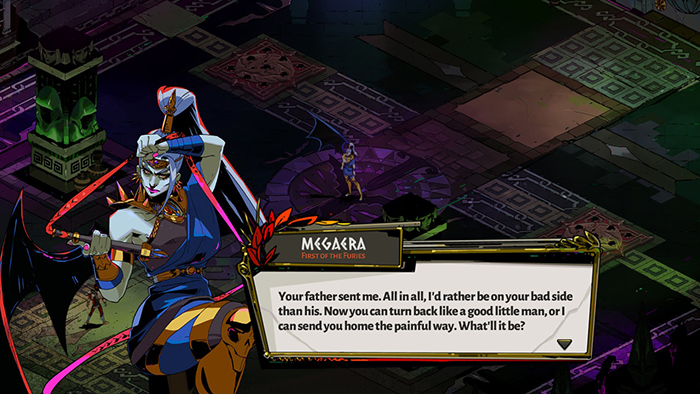
You’ll have to fight them multiple times as you’ll be replaying each biome. This can normally get repetitive, but Hades stirs up the playing ground by introducing different bosses or tougher variants. The aesthetics aren’t the only difference. The upgraded version of the boss will play differently but maintain the original’s body structure. They can also be harder to eliminate, so extreme caution is a necessity.
The game has a variety of weapons; however, you’re limited to a sword when beginning the game. New weapons become accessible the more you play, with a total of six in the game so far. Accessibility to these new weapons requires specific amounts of keys to unlock them. These keys are normally found during runs, but can also be obtained from the lounge’s trade dealer over a transaction.
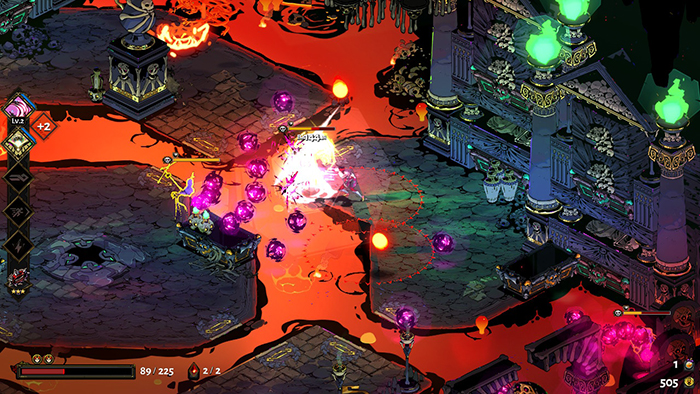
The weapons in the game offer new playstyles to dive into, from close-combat to long-range attacks. Their visual attacking styles are distinctive enough to tell them apart. At least one weapon should appeal to each player, whether they like to smash into their enemies or play at a safe distance. Each weapon possesses a normal and special attack; these attacks can be enhanced during runs with temporary upgrades.
Hades is heavily based on grinding, but don’t call it quits just yet. The type of grinding involved is retrying escape attempts, which will come naturally when playing. The game doesn’t have much stage content and focuses more on its replayability, but there’s an extremely low chance of completing the game within the first several runs. You’ll have to farm and upgrade your permanent stats, learn the best temporary upgrades to choose on runs, and figure out how to overcome each boss’s line of attacks.
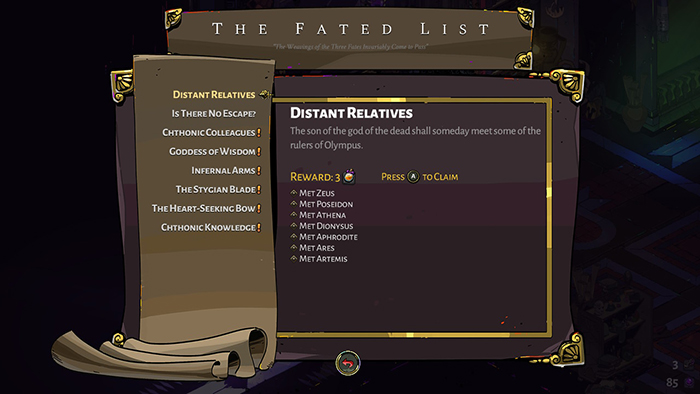
Upgrading your permanent stats will take a while. It’s not the type of annoying farming you may have come across in other games. Hades does a stellar job at catering for replaying its levels. With the game’s sheer difficulty, it never becomes a nuisance. Instead, it feels more wholesome having additional tasks to do before finishing the game’s main objective. Each failed attempt at making it out of your current hellhole refreshes the dialogue between characters and lets you dive more into the game’s story.
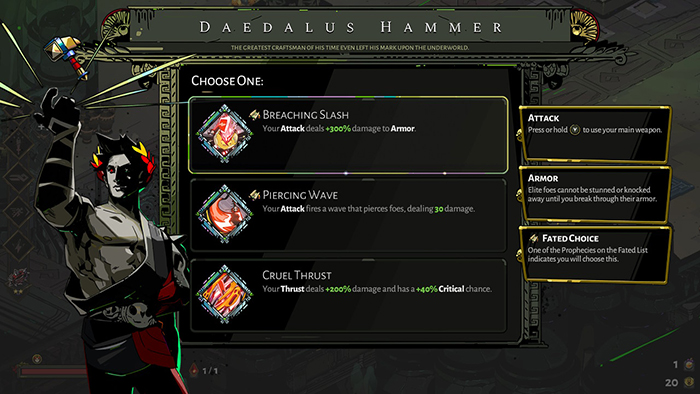
Darkness is an item you must acquire to offer to your mirror. This lets you choose between several options to strengthen your character. The list of permanent perks you see can be expanded with more options, but not without further grinding for keys. Keys not only unlock weapons, but can be used to unlock additional perks to purchase with the Darkness currency. In addition to Darkness, gemstones (and the more valuable item, diamonds), can be obtained from runs to modify the appearance of the underworld, The House of Hades.
The gods will assist you during your runs with some of their power. Each god focuses on a specific type of power and choosing between them is up to you. All of these upgrades you’ve obtained during your run are temporary and will be removed from your possession upon death. Interacting with each upgrade normally prompts a dialogue screen with the respective god. It’s always interesting hearing what they have to say. However, it can sometimes get skipped when too many of their dialogue triggers, so you can focus more on the gameplay.
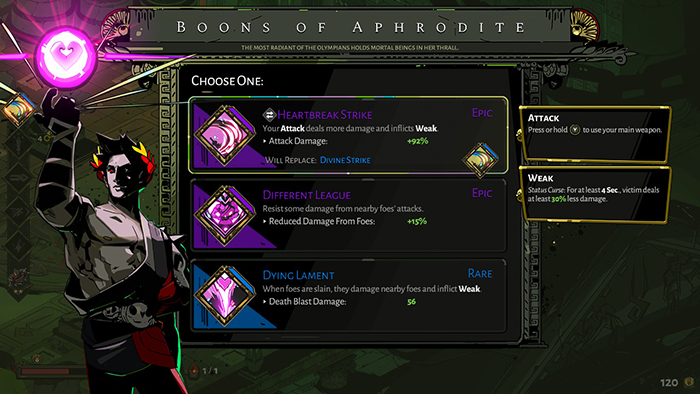
At the start of a run and after clearing a stage, you’ll get a taste of this power. Learning about them and utilizing the Boons that fit your playstyle will be to your advantage. These powers can increase the strength of your attacks, heighten the rate of the weapon’s speed, inflict effects on targets, upgrade your weapon’s area of attack, enhance your abilities such as changing your special attack or causing a rift after a dash, and the list goes on. There are many upgrades you’ll be able to sink your teeth into and discovering them all will be captivating.
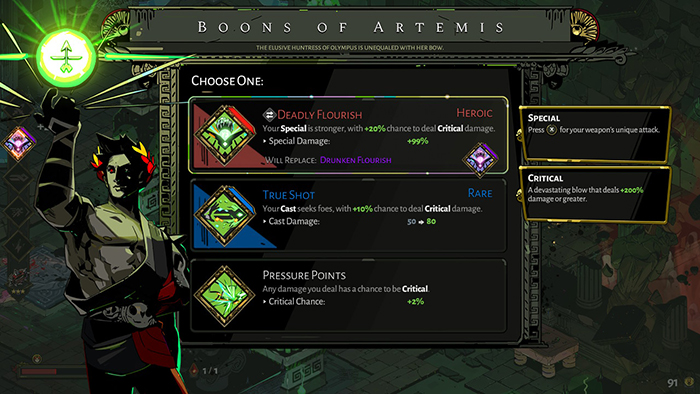
Each Boon has a rarity. The standard rarities are common, rare, epic, and heroic. The Heroic rarity is the strongest out of the standard set and can only be acquired through certain means. In addition to the standard Boons, there are special Boons; these are duo, legendary, chaos, and bouldy. They, of course, are stronger than the majority of standard Boons and are also much rarer.
Hades is different from roguelike games that force you to restart with the bare minimum. You’ll lose the upgrades you accumulate during dungeon runs, but you can keep the upgrades you’ve purchased from the Mirror of Night in your bedroom. These upgrades will drastically help you during your runs, but take a fair share of Darkness to obtain.
Some of these permanent upgrades can increase your attack power, heighten the rarity of Boons you collect during runs, add to your maximum HP, grant you coins at the beginning of a run, and more. The majority of these upgrades won’t be available at the beginning of the game. Accessibility to the majority will require collecting keys to unlock more options.
There’s no denying that Hades is a brutal game. You need to ascend from the depths of hell through four biomes and you’ll encounter many challenging foes along your journey. Die, and you start from the beginning again. It’s about choosing the right upgrades during your run, using your skills efficiently, and avoiding as many enemy attacks as you can. The game’s difficulty might rub some casual players the wrong way, but thankfully, the developers implemented a God Mode which makes the game easier.

The changes do not take immediate effect, though. God Mode makes Hades easier, but it takes its fine time at it. It’s far from bad. A much easier mode would make Hades a boring game with the limited content it currently has. The developers have found a compromise to balance difficulty with casual play; each time you die, your resistance to enemy attacks grows by 1%. This is the mechanics behind God Mode and the percentage gets higher the more you die, making stages less of a worry with each death.
During your journey, you can collect gemstones and diamonds. Their primary usage is trading them for house decor, unlocks, and repairs at the House Contractor. Here, you can decorate the different rooms of The House of Hades to fit your aesthetic from the provided options available. There are many items you can purchase, although it’ll take a bit of grinding to collect them all.
There’s no preview button before purchase. At most, you’ll see a smaller version of the item alongside its name and price tag. You also won’t have the freedom of item placement, but that isn’t anything unexpected because it isn’t the focus of the game. If you dislike an item you’ve bought or where it’s being placed, closing the game may return your funds, but don’t get your hopes up because you might fall victim to autosave.
Befriending the characters in the game has its perks. Giving a character the Nectar you obtain from runs will likely reward you with a keepsake and can eventually get you a Companion. These keepsakes are useful during runs by enhancing your performance, such as raising your maximum HP or dictating the next Boon you’ll encounter. Companions, on the other hand, allow for a unique summon ability per run and can be upgraded.
It can get tiring facing the same bosses and hordes of enemies repeatedly. There’s only a matter of time until you’ll grow exhausted from farming for all of the collectibles. The developers of Hades have shown interest in releasing new content for the game. No new, major post-launch contents will be released, but there’s a chance of additional, new content being added at some point in 2021 once the team has recharged.
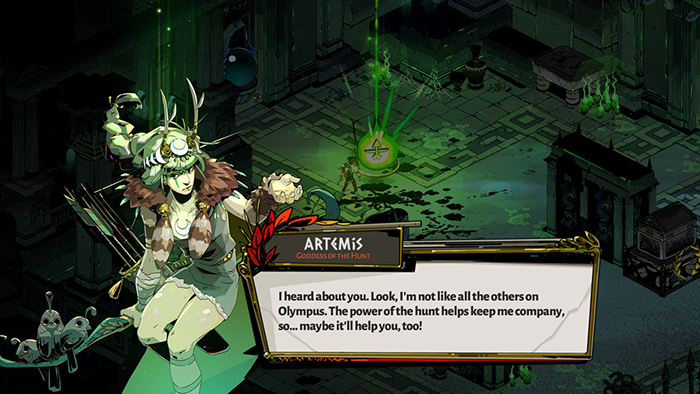
The four biomes can be disheartening to some players, so extra would really make the game worth reinvesting more time in. Additional bosses and enemies are a must to keep veterans in check. Surely they wouldn’t be attracted to the idea of climbing from the get-go just to access new content at the end. Climbing the early stages can get tedious if done that way.
After unlocking the House Contractor, you’ll eventually be able to purchase an item that allows for music playback. You’ll be able to listen to the game’s astonishing tunes straight from the main hub area, but there’s a catch. You’ll have to grind your way to unlocking each song. It adds to the various list of rewards you can grind for, further increasing objectives for you to complete.
The game supports English voice acting and it’s utilized well throughout the many conversations you’ll have in this game. The voices used are fitting for their respective characters and sound powerful enough to be seen as either a god or a goddess. Big papa Hade’s rage is greatly expressed during red alarms where he is tripped off more than usual. You can almost feel as though he’s angry at you from the other side of the screen while you’re tarnishing the place and stealing his treasures.
From the environments to the character art, Hades is a game that’s visually appealing to the eye. Character models, traps, and attacks are clearly seen in motion. Each biome has its own unique theme, making it apparent that it’s a new environment. On top of that, the game runs flawlessly on the Nintendo Switch. There’s absolutely no lag or framerate drops when fighting enemies.
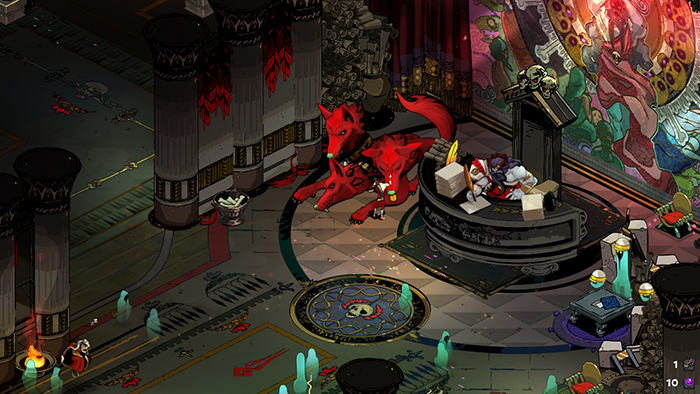
The soundtrack is fantastic as well. The opening tune at the beginning of a run never fails at revving you up for what’s to come. All of the songs make smashing through enemies and advancing through stages a pleasant experience. The sound played during the red alarm stages are terrifying as ever and compliments the irritated father’s voice nicely.
Hades is a brutally tough ARPG that’ll keep kicking you down the rabbit hole, but you’ll finally get the last laugh after enough attempts under your belt. It shows mercy with its permanent upgrades and easier God Mode difficulty, yet there’s still no escaping death. The content is limited, but the replayability is godlike. Its $24.99 price tag seems like a steal for the experience you’ll have with the game, especially considering the possibility of future content releases.
Hades gets a 9/10.